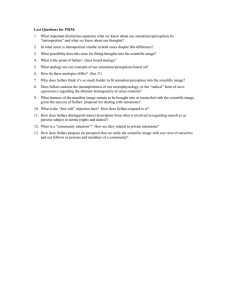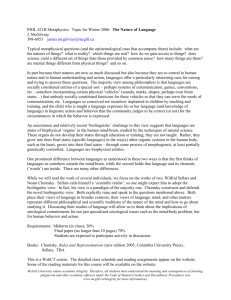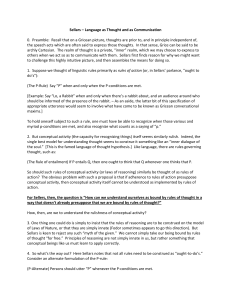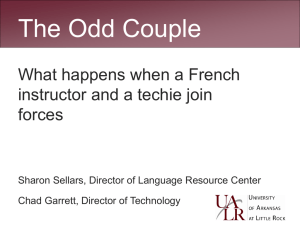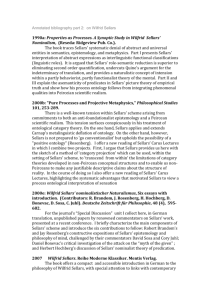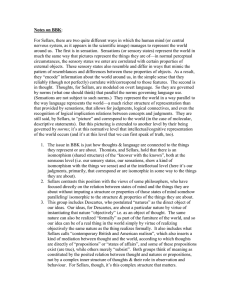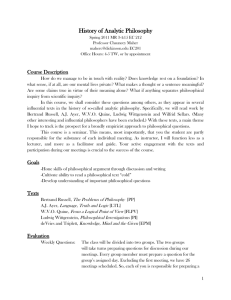Notes on Phenomenalism. 1. General Remarks:
advertisement
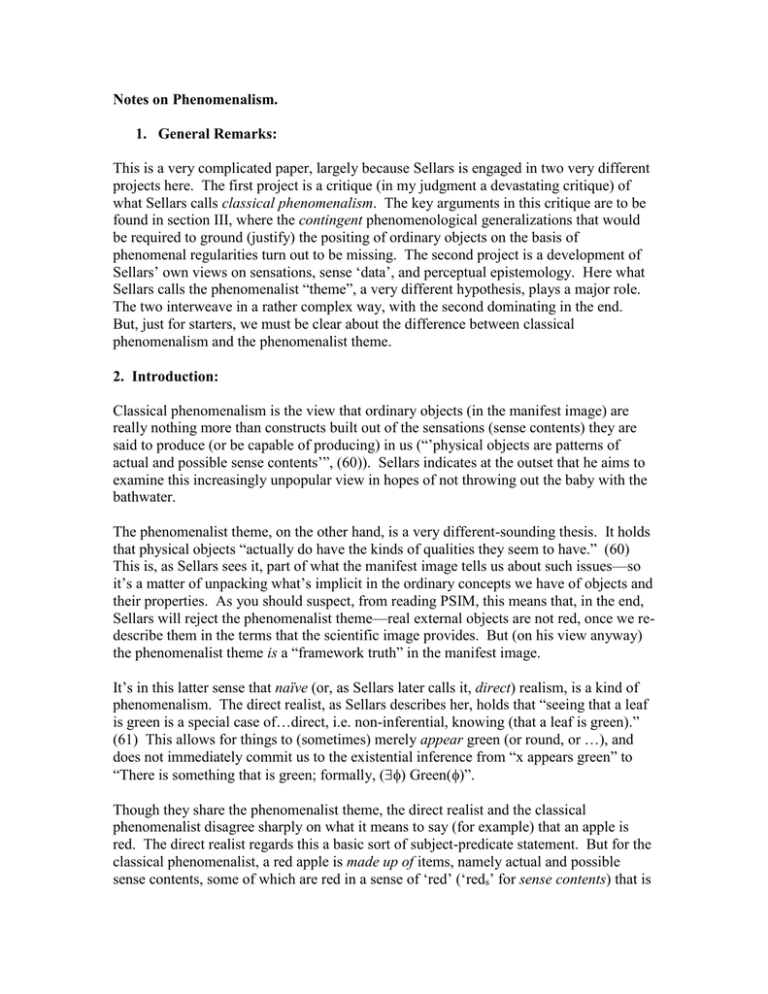
Notes on Phenomenalism. 1. General Remarks: This is a very complicated paper, largely because Sellars is engaged in two very different projects here. The first project is a critique (in my judgment a devastating critique) of what Sellars calls classical phenomenalism. The key arguments in this critique are to be found in section III, where the contingent phenomenological generalizations that would be required to ground (justify) the positing of ordinary objects on the basis of phenomenal regularities turn out to be missing. The second project is a development of Sellars’ own views on sensations, sense ‘data’, and perceptual epistemology. Here what Sellars calls the phenomenalist “theme”, a very different hypothesis, plays a major role. The two interweave in a rather complex way, with the second dominating in the end. But, just for starters, we must be clear about the difference between classical phenomenalism and the phenomenalist theme. 2. Introduction: Classical phenomenalism is the view that ordinary objects (in the manifest image) are really nothing more than constructs built out of the sensations (sense contents) they are said to produce (or be capable of producing) in us (“’physical objects are patterns of actual and possible sense contents’”, (60)). Sellars indicates at the outset that he aims to examine this increasingly unpopular view in hopes of not throwing out the baby with the bathwater. The phenomenalist theme, on the other hand, is a very different-sounding thesis. It holds that physical objects “actually do have the kinds of qualities they seem to have.” (60) This is, as Sellars sees it, part of what the manifest image tells us about such issues—so it’s a matter of unpacking what’s implicit in the ordinary concepts we have of objects and their properties. As you should suspect, from reading PSIM, this means that, in the end, Sellars will reject the phenomenalist theme—real external objects are not red, once we redescribe them in the terms that the scientific image provides. But (on his view anyway) the phenomenalist theme is a “framework truth” in the manifest image. It’s in this latter sense that naïve (or, as Sellars later calls it, direct) realism, is a kind of phenomenalism. The direct realist, as Sellars describes her, holds that “seeing that a leaf is green is a special case of…direct, i.e. non-inferential, knowing (that a leaf is green).” (61) This allows for things to (sometimes) merely appear green (or round, or …), and does not immediately commit us to the existential inference from “x appears green” to “There is something that is green; formally, () Green()”. Though they share the phenomenalist theme, the direct realist and the classical phenomenalist disagree sharply on what it means to say (for example) that an apple is red. The direct realist regards this a basic sort of subject-predicate statement. But for the classical phenomenalist, a red apple is made up of items, namely actual and possible sense contents, some of which are red in a sense of ‘red’ (‘reds’ for sense contents) that is more fundamental than the sense in which the apple is red (‘redp’ for physical object). Roughly, what makes the apple red is the fact that some sense contents that “make up” the apple are themselves red—these are, in turn, visual sense contents that arise when the apple is viewed under “normal” viewing conditions. For now, we won’t try to dig any deeper here—but the challenge of sorting out, in a non-circular way, what counts as normal viewing conditions, will turn out to be important as we go along. This leads us to another important difference. A black sense content that results from viewing a green leaf under red light (a kind of non-normal viewing condition) is just as real, and just as much a part of the complex of sense contents that “make up” the leaf, according to classical phenomenalism) as the green sense contents that result when the leaf is viewed under normal conditions. And this means that (at least as far as reds goes—and reds is considered the more basic of the two senses of red) the existential inference above will go through. Whenever a physical object seems redp, there will be some sense content that is reds. This way there’s something guaranteed to be veridical in our sensory awareness— whenever something looks φ to us, while there may be no object that is φp, there will at least be a sense content that is φs. This epistemic theme is an important motivation in philosophical attempts to avoid skepticism of the senses by finding a set of sensory reports that cannot be mistaken, and so could serve as an infallible (and psychologically indubitable) “foundation” for sensory knowledge. Finally, Sellars considers (and rejects) a view of the colours of physical objects that is, in a way, intermediate between classical phenomenalism and direct realism. This view posits “surfaces”, where these are not (thin) 3D parts of physical objects, but more abstract, 2D particulars that are somehow the “real” bearers of colours, and are either part of or “attached to” the 3D objects we normally describe as coloured. This view shares with the classical phenomenalist a kind of separation between 3D ordinary objects, and the “real” or “fundamental” bearers of colour properties. And it may even hold (with the phenomenalist) that real objects are constituted by actual and potential colour “surfaces”. But it shares with the direct realist the claim that the things that have colours are parts of the public, shared world we live in, and that these things can seem to have colours different from the colours they actually have. (Sellars also considers and rejects the view that ordinary coloured objects are really 3D continua of coloured “points”. Note here that there’s a cautionary note re PSIM implied in Sellars’ skepticism re. this position.(69, middle paragraph) The ultimate homogeneity of colour that Sellars refers to in PSIM should not be conceived in terms of a 3D continuum of coloured points, but as a structure of 3D regions and subregions, all of which are homogeneously coloured, but which is not correctly analysed as a 3D continuum of 0-dimensional coloured points.) Sellars takes the move from the direct realist view of seeing an apple to a view holding that we directly see part of the “surface” of the apple and inferring the apple to be a first step down the garden path (or slippery slope) to phenomenalism. Surfaces in the sense invoked here are in principle independent particulars, capable of existing on their own— so it becomes tempting to employ them to account for how things seem to us when, for instance, we seem to see something red but no red object is present. All we need is an “unattached” red surface that we saw to be present, and it becomes “clear” how we could seem to see something that wasn’t there, and what that seeming consists in (the perception of unattached colour surfaces). (S introduces “pure-seeing” here for this seeing of mere surfaces, regardless of whether they are attached to a 3D object or not.) This move is not obligatory, though—just tempting. But to limit surfaces to “seen” surfaces is to shift sharply in a phenomenalist direction. The main point of looking at both these views here is to separate the mistaken view that objects are not seen, but their (public) surfaces are (and these surfaces can look to have colours other than the colours they do have), from the more drastic errors of phenomenalism. The phenomenalist view shifts from public to private surfaces, which are always whatever colour they look to have. But the parallel between the two remains striking: in both cases, there is an epistemically privileged, direct sense of “sees” (sees1) in which we see these surfaces, and an epistemically secondary, indirect sense of “sees” (sees2) in which we see “objects” when we (correctly) attribute directly seen surfaces to public 3D things. Sellars declares that he, too, accepts that an element of MacBeth’s visual experience, when he seemed to see a dagger before him, was a dagger-shaped colour expanse. But he will “locate” this fact rather differently than either the surface-oriented DR or the phenomenalist does. Recall PSIM again here, where colour is moved out of the world, but we are promised that it will be retained in our account of the conscious brain, in the form of properties of regions of the brain that are structured and that resemble-and-differ in ways that parallel the conceptual space of colour properties. II. Sense Contents The next step in Sellars’ project here is to examine the notion of sense contents. These are the building blocks of ordinary objects for a classical phenomenalist, so part of the point here is to see what views on the nature of sense contents can play that role. But Sellars himself believes in sense contents, in a sense. So another part of the point here is for Sellars to lay out at least some constraints on what he regards as a correct account of the. He considers 3 very different views of sense contents (and they are very different, despite sounding rather similar). The simplest of these is founded on ordinary talk about perception, but substitutes a new, technical use of “directly see” for the usual “see”. So, while we ordinarily speak of seeing an object as seeing that it has some (visual) properties, we are now also said to “directly see” colour “surfaces” or “expanses” and to “directly see that” they have certain properties. “Direct seeing or perceiving” is then translated to “sensing”, and the objects of such sensings (what we sense when we have such sensings) are taken to be sense contents. Common inference patterns are retained here, so we can infer from “S directly perceived (or sensed) X” that “There is an X (that S sensed).” And we retain the possibility of such things existing unsensed, just as ordinary objects can (Hume is pretty explicit on this in his Treatise of Human Nature). Finally, we retain the possibility of these things being other than how they appear, and the independence of the existence of these items from our sensing them (Hume waffles oddly on this). The second assimilates perception to thought, (“…it would not be amiss to say that the fundamental model of this second approach is the framework of categories traditionally used to explain the status of the objects of thought” (68)) and regards the inference from: Someone senses a red and triangular expanse. To There is a red and triangular expanse. As a mistake that parallels the mistake of reasoning from Someone is thinking of a golden mountain. To There exists a golden mountain. Esse is percipi: to be is to be perceived. Sellars links this second view of red and triangular expanses to this doctrine—the sensory awareness of an R&T expanse is of something whose existence consists (or may consist) merely in being perceived, just as the thought of a golden mountain is of something whose existence consists, or may consist, merely in being thought of. But it is compatible, thus far, with the view that such expanses MAY also exist in a further sense (as part of the publicly observable world). But the second approach to sense contents rules this out, making the perception of such things precisely what is required for their existence. Another way of approaching this view is to regard it as saying that, properly speaking, the phrase “red and triangular expanse” can only characterize sensations—nothing else (in particular, given the privacy of sensations, nothing in the public world) is really a red and triangular expanse. Or (in the material mode) “there are no red triangles, only sensations of red triangles.” (69) This still allows for sense content talk, but only in a trivial sense. “There is a red triangular sense content” gets defined as “Someone is having a sensation of a red triangle”. The upshot is that sense content talk gets trivially turned into talk about sensations. So it doesn’t add much to ordinary perceptual talk. On the other hand, someone from group 1 might endorse the same claim, that esse is percipi goes for sensations in her sense. But to do so is to say something odd & in need of explanation. If red triangles are in principle a kind of individual thing, we need an account of why, in order to exist, they must be perceived (i.e. why they cannot exist without participating in a relation—of being perceived—with some other thing). But the second view, with sense contents modeled on thoughts, has much less trouble adopting the “esse is percipi” view of sense contents (in effect, the resulting position comes down to claiming outright that nothing is red and triangular, or—to put it in a meta-linguistic mode of speech—‘x is red and triangular’ is ill-formed, EXCEPT in the case where x is a sense content, and in that case this is defined trivially as meaning that someone is having a sensation of a red triangle). Now, the structure of what’s going on here is complex—recall that Sellars is exploring and developing a view he doesn’t hold, while dropping hints about the view he does hold. So part of the time he’s giving an account of the lay of the land, and trying to see what sort of view a phenomenalist would have to hold. But some of the time he’s commenting and making suggestions that point towards his actual position. Both these are tangled up here: The three categories of phenomenalism are explored both as possible routes to a version of classical phenomenalism, and as potential parts of a position Sellars will endorse. The next point Sellars makes is a remark about the link between sensing and knowing. The first view of sense contents makes the having of a sensation a kind of knowing, drawing on the parallel between “S saw x” and “S saw that p”, where x is (of course) some individual thing, while p is a sentence. The second, with its roots in our account of thoughts, does not allow for sensations that at all; sensations are strictly of individuals, and while we can know we are having a sensation of some kind, the having of the sensation is not itself a bit of knowledge. So the first allows ‘S senses that x is red and triangular’, which is clearly a case of perceptual knowledge, and generally links visual awareness of individual things to awareness of some fact(s) about them. The third approach to sense contents “equates ‘S has a sensation of a red triangle’ with ‘There appears to S to be a red and triangular physical object in a certain place.’ ” (71) So the key move here is to start from “appears” talk & build sensation & sense content talk on it. This (like the second) has the immediate result that the existential implication fails—we can’t infer ‘A red triangle exists’ from ‘S has a sensation of a red triangle’. But by introducing sense content talk, we can recover a sense in which the existential inference will hold: If we let ‘A red and triangular sense content exists’ have the “translation” ‘(S) (x) S has a sensation of x x is a red triangle’, then we get the entailment, but it’s restricted to sense contents, a special sort of thing whose existence is guaranteed by the existence of the (right kind of) sensation. The key turn for the third approach, though, is another epistemic point: The fact that there appears to me to be something of some description over there is not a knowing in itself, but ‘it is facts of this kind which are directly known in sense perception.’ (71) So again we get a link with foundationalist epistemology, in which facts about what appears to us are the (infallible, indubitable) base on which perceptual knowledge is to be built. Carefully handled (see top of 72) this line can be developed to remove every commitment to an external world in our characterization of the sensations which are what we know directly in perception. But the “appears” talk remains at the root of this view, and what appears to us in sensation is described in terms borrowed from the language for everyday, public objects and their sensible qualities. This link, Sellars says, makes it absurd to combine the third approach to sense data with classical phenomenalism: To do so is to get tangled in an ugly conceptual circle, since it requires identifying objects with actual and possible sense contents, but it defines sense contents in terms of it appearing (to some subject) that there is a physical object somewhere. (72) The classical phenomenalist can accept that a subject’s having sensations of a certain kind goes together with it appearing to the subject that there is a physical object of that kind somewhere. But she must not define the first in terms of the second. Here Sellars finally tips his own hand—he will defend a version of the second approach, treating sensations on the model of thoughts. But he does not assimilate them to thoughts (as we saw clearly in his objections to Thomism in BBK). At this point Sellars proposes to extend his account by examining the relations between the second and third approaches to sense contents. On the third account, it turns out, having a sensation is a form of thinking, since ‘having it appear to one that there is a red and triangular physical object over there’ is a case of thinking in that broad sense in which wondering, wishing, resolving, etc., as well as judging, reasoning, etc., are modes of thought’ (72-3). The key point here is the use of ‘that’, which indicates a propositional content and identifies what appears to us with what we judge when we take things to be as they appear. So, as Sellars puts it ‘Being appeared to is a conceptual—though not merely a conceptual— state of affairs. One can’t be appeared to unless one has the conceptual framework of physical objects in Space and Time.’ But in Sellars’ version of the second position, having sensations is not a conceptual fact, and doesn’t require that one have some conceptual framework. An infant who doesn’t yet have any concepts can still have sensations in Sellars’ sense, but she couldn’t have it appear to her that a red triangle is over there. And now we come to a familiar point from BBK: Sellars regards ‘S has a sensation of a red triangle’ as meaning (having the sense of) ‘S is in that state which is brought about in normal circumstances by the action on the eyes of a red and triangular physical object’. (To be a little more specific about this state, it’s worth adding that it is a sensory response to exposure to such objects in normal sensory conditions that arises independently of any particular conceptual system, and even independently of whether the subject has yet acquired a conceptual system allowing her to respond to the sensation with some thought or other.) Of course this account of sensations does require (at this point) the existence of red and triangular physical objects, though there need not be such objects every time such a sensation occurs. So “esse is percipi” cannot apply to red triangles in general on Sellars’ view. (74) An alternative would be, not to use this approach to explain why the existential inference fails, but just (on the model of thoughts) reject the inference. Sellars thinks this is fine, but only if we resist the temptation to assimilate sensations to thoughts. Historically, the temptation has proven hard to resist—for example, if, following Aristotle, we regard a sensation of a white thing as an awareness of the thing as white, then we bring in a basic “form of judgment” (subject-predicate sentence) as part of what having a sensation involves. The line between sense and intellect becomes a line between awareness of individuals as characterized in particular, determinate ways, and ‘consciousness of the general (All S is P), the generic (S is an animal) and the abstract (Triangularity is complex). (Note here how the general involves more than individuals, the generic involves indeterminacy, and the abstract involves things that we cannot be sensorily aware of.) This alternative has (for Sellars) an attractive feature—it does allow us to relegate all red triangles to perception, and declare that, aside from a (Lockean) “powers” mode of speech, ‘red triangle’ occurs correctly only in contexts of the form ‘S has a sensation of (a red triangle)’. This is attractive, of course, because Sellars ultimately wants to do this, adopting a framework in which nothing in the public world is really coloured. But it is not an essential part of this version of the third approach to sense contents. And if we continue, within it, to allow both sensations of red triangles and real red triangles ‘out there’, then we get a view in which the link between sensations of red triangles and the states that are ‘brought about in normal circumstances by the action of red and triangular physical objects on the eyes’ is not how we define such sensations, but instead is either synthetic (something we find out about the world) or analytic because we define red and triangular objects in terms of the kind of sensations they cause in normal circumstances. These remarks are essential to clarifying the relation between classical phenomenalism and these various views of sensations and sense contents. The form of the second view that defines sensations in terms of states brought about by the senses (in normal circumstances) in the presence of objects won’t do, because it makes the very idea of a sensation dependent on our having the concept of as applying to ordinary public objects. And the third view won’t do at all, since it too would make classical phenomenalism conceptually circular. So only the first (the sense-datum) position and the second form of the second position (as just described) are available to the classical phenomenalist. (76) The first approach is modeled on ordinary perceptual talk, and makes sense data the direct objects of our sensory awareness. This suggests that they could exist unperceived, and requires a bit of dodging between a cognitive model of ‘directly seeing’ such things and their qualities and a non-cognitive one which could allow room to impose an ‘esse is percipi’ doctrine. This position will still allow sense contents to exist unperceived in the cognitive sense. III. Possible sense contents This section presents an important argument against classical phenomenalism. The argument turns on the difficulty of sorting out the role of “possible sense contents” in the classical phenomenalist’s account of ordinary objects. Sellars begins by pointing out that ‘possible sense contents’ are better described as ‘conditional sense contents’. We think of them as the sense contents we (or other subjects) would have if we were in a different position than we are, if we were looking in another direction, if the lighting were different, if something were moved or heated or cooled, or examined under a magnifying glass or microscope, etc. Actual sense contents, by contrast, are sense contents proper (i.e. the word ‘actual’ doesn’t add anything). The ‘conditional’ here involves a link to circumstances (i.e. the actual ones), alternative courses of action, and the results of those courses of action. So possible in this sense is a matter of what would happen, given the actual circumstances, if we took some alternative course of action. (This is quite different from the epistemic sense of possible, as in “It’s possible for all I know, or given our evidence, that George W. Bush will be re-elected this November”, which simple asserts the compatibility with my knowledge or our evidence of things turning out that way.) Using his example of skids and conditional skids, to say that a conditional skid exists is to say that the circumstances and courses of action open to the driver are such that at least one course of action open to her would result in a skid. (If we add in probabililties in the sense of objective chances by saying that a course of action has a chance of producing a certain result, this could be adapted to say “might result in a skid” instead—but if we add in epistemic possibilities, as in “might, for all we know, result in a skid”, there may really be no possible skid in Sellars’ ontological sense at all.) Establishing such claims requires induction, because there’s no logical link between circumstances, courses of action, and results that would support these counterfactual conditionals. They are matters of fact, and need evidence that we can only get by noticing what happened in relevantly similar circumstances when certain courses of conduct were adopted. Obtaining such evidence for possible sense data requires that we establish facts about the circumstances, facts about courses of action open to the observer, and facts about the sense contents that result. If we aren’t pursuing a form of classical phenomenalism, then we can simply characterize circumstances using the ordinary thing language, as Sellars does towards the bottom of page 79. But if we want to arrive at a form of classical phenomenalism, our account of the circumstances (and the courses of action open to the observer) will (in the end, at least) have to be in terms of sense contents, not ordinary thing talk. And if we can’t do it strictly in terms of actual sense contents, we’ll be launched on a difficult translation project, since we need to translate the conditionals “behind” each conditional, and assure ourselves that in the end we can bring it all off without circularity. Worse yet, the regularities linking various sense contents involved in one such conditional will presuppose regularities involved in the others we need to translate its conditions (without them our attempts to specify circumstances in phenomenal terms will fail), and this regress of presupposed regularities undermines the whole enterprise. Further, we have no hope of capturing these generalizations with actual sense contents only, since the circumstances they invoke are specified in terms of objects and their relations, whose analysis (as already declared by the phenomenalist) involves both actual and possible sense contents. But an escape remains for the classical phenomenalist. She can defend her view by holding that the ordinary regularities framed in terms of objects and our relations to them are not the regularities that get phenomenalism started. Instead, she may claim that there are other regularities that can be cast in terms of actual sense contents, and it’s these that provide the starting point for inductive reasoning about sense contents. (The more familiar regularities in terms of ordinary objects would then appear as highly derived, theoretically framed regularities that extend and improve on the purely phenomenal regularities we began with.) So we face the question, ‘(a)re there inductively establishable generalizations about the occurrence of sense contents which make no reference to either physical objects or conditional sense contents?’ (80-1) There is no contradiction in the notion that there might be such generalizations. But (as a matter of fact) are there any? Here a crucial distinction arises, between accidentally and essentially autobiographical (A and E) generalizations. The difference is between generalizations that depend on the particular physical environment someone lives in, and generalizations that hold independently of the observer’s physical environment. The generalizations in question all have the (rough) form: ‘Whenever (or for the most part) I have such and such a pattern of sense contents, I have a sense content of the kind in question’ (81) But A generalizations will continue to hold if we substitute ‘anybody’ for ‘I’, while E generalizations will not. Sellars’ conclusion, after a short debate between realist and phenomenalist, is that ‘the uniformities each of us finds are not only autobiographical, they are expressions of the fact that each of us lives among just these physical objects. (And the fact that these objects, in turn, are related in certain definite ways.) So there is no salvation here for classical phenomenalism. The limited phenomenological regularities we do know are a product of the environment each of us lives in, as described in the framework of ordinary objects. Of course that sort of generalization can’t be the source of the conceptual framework of ordinary objects that we all learn “at mother’s knee”. So, even though I (and each of us) may be able to produce inductive generalizations in phenomenal terms that (more or less) hold in our experience, they do not provide a system of generalizations that are sufficiently rich and general to ground ordinary objects as an explanatory theory of independently established sense-content generalizations. Worse yet (83-4), Sellars thinks these E-generalizations are tainted with our ordinary concepts of perceivers and the world around them as well. We select patterns that we know are supported by the facts about ourselves and our actual environment, rather than notice the patterns themselves amidst the “booming, buzzing confusion” of raw experience. And so we know at the outset that these generalizations are dependent on our particular circumstances, and cannot contribute to establishing the abstract generalizations that take these dependent regularities and extend them beyond our own autobiographical circumstances. More generally, Sellars announces that this line of argument provides just a special case of the broader fact that the entire conceptual framework of sense contents is logically (i.e. conceptually) dependent on the framework of intersubjectively accessible public objects and persons. IV. The New Phenomenalism. The burden of this section is to argue that a new form of phenomenalism, grounded in a combination of (positivist- style) anti realism with a hypothetico-deductive view of theories relations to the observations that test them, is untenable for the same reasons we have just seen make classical phenomenalism untenable. The HD approach to theories holds that theories can be treated as inferential machinery, and they are tested by whether the predictions we get, when we apply that inferential machinery to our observations, turn out to be true. So the important thing is not whether we can “reduce” or translate the theoretical vocabulary into the observation language— this is not required at all. What is important is that we can test the theory by applying it to make predictions that can be observationally tested. But Sellars’ account of this sort of observational testing requires that there be inductively established generalizations in the observation language, that correspond with generalizations that we can derive from the theory, and no inductively disconfirmed generalizations in the observation language that correspond to generalizations we can derive from the theory. And so we end up with the same problem—we need to be able to inductively support (and disconfirm) observations in the language of sense contents if we are to justify (in the HD way) the “theory” of ordinary objects on the basis of what it does for our understanding of sense contents. V. Direct Realism. Here Sellars reintroduces his inclination to direct realism. But the key distinction is between two senses of ‘direct’. In the first sense, ‘direct’ means causally immediate. Immediacy in this sense doesn’t apply to our sensory knowledge of objects around us. The properties of objects around us are clearly indirect causes of our perceptual knowledge of them—for instance, in the case of a red triangular surface, the surface must be normally illuminated and facing us, and we must have our eyes open so that the surface can interact with the light, and some of that light pass through the pupil of the eye, strike the retina, and signals travel from the photosensitive cells down the optic nerve and into the various visual centres of the brain. Only then, after passing through many causal intermediaries, do we end up with a visual awareness of the surface, its colour and its shape. But in the second sense, ‘direct’ has an epistemic force. Here it means justified without having been inferred from other justified judgments or beliefs or claims. And in this sense, our ordinary everyday awareness of our surroundings includes a lot of directly known facts about them. The key point in this notion of “knowledge” is to understand the sort of justification such claims have. Here the notion of ‘trans-level inference’comes in. Schematically, in a trans-level inference, we infer ‘Probably p’ from ‘X’s thought that-p occurred in manner M’. On this account, merely thinking that p, in the right circumstances and as a result of the right sorts of processes, can be evidence for believing p. (In a sense, we might say that such beliefs are self-justifying, but only when they occur in the right sort of circumstances.) Sellars puts off giving a serious account of this kind of inference. Sellars puts some effort into blocking any backsliding here, arguing that worries about what we really see when we (say) look at a book are fair enough if we are careful to say that while we see the book, what we see of it is its facing side. But we must resist the temptation to make an epistemic meal of this limitation, and suggest that what we really see directly is a “surface”, in some sense that sharply distinguishes surfaces from ordinary objects, while we only see objects indirectly. Further, the possibility of inferences does not demonstrate that they are always present. So, while I could and sometimes do infer that there is a object over there from the fact (under the right circumstances) that it appears to me that there is, or that I’m aware of a sense content, it doesn’t follow that whenever I judge that I’m seeing a object, I’m making an inference. Sometimes the judgment is made as a direct response to my environment. (And, in fact, this sort of direct judgment is crucial to acquiring the conceptual framework of objects and perceivers that I need in order to be able to speak— or think—of how things appear and even of sense contents.) Finally, the special “security” of saying “there appears to me to be a object” or “I am now aware of a sense content” (in the sense that I can be right about these claims even when I would be wrong to say that there is a object out there) does not ‘impugn’ the directness of the knowledge when we correctly judge, in the right circumstances and without any inference, that there is a object out there. When we think of the directly observable properties of objects here, Sellars takes it that we do regard objects as really having the kinds of properties they seem to have. So this direct realism does accept the phenomenalist theme. But it treats these properties as (at least first and foremost) properties of publicly observable, intersubjective objects in space and time. At this level, we can really arrive at some useful inductive generalizations that can (and do) provide support in roughly HD ways for theories and their entities. But we have to keep in mind that the concepts we apply to such observable objects are not acquired just by sensing them. Concept acquisition occurs through the process of language learning, through which inferentially articulated concepts and judgments we can make in their terms come to be linked (applied) to the world around us in ways that our fellows can evaluate and respond to. So we return to the rich causal mediation of what is (from the epistemic/inferential point of view) our direct knowledge of (certain features of) our environment. Sense contents themselves, from this point of view, are causal intermediaries, not (themselves) bits of knowledge from which ordinary claims about the world around us are inferred. VI. Sense impressions. Here Sellars tips his hand on sense contents or impressions: they are best understood as theoretical entities, which have been postulated to explain certain facts about illusions and mirrors and other such circumstances in which things seem to be something they are not. This is not a rejection of sense impressions, since Sellars thinks that theoretical entities are perfectly respectable: for Sellars, if we have good reason to accept a theory, we have good reason to believe in the entities it postulates. We can even learn to make observation reports directly in the theory’s language. And when this practice of observation is successful, we can learn to make such reports (autobiographical reports about our own sense impressions, in particular) and even come to treat them as “konstatierungen” (basic observation statements). Logically, sense impression talk is not relational. Having a sensation of a object is not a relation between the subject and a particular. It is a one-place property of a subject; in fact (more delicately), it is fundamentally adverbial. When we say someone is having an impression of a white snowman, we are describing them as in a certain kind of state, and not describing a thing that their impression is “of”. To be in this kind of state is to be undergoing a certain kind of process—and since processes are happenings (like runnings, or appearings), words for kinds of processes are (grammatically) adverbs. (See 94-5 for a subtle development of this claim.) Sellars proposes to illuminate what sense impressions are by exploring how they function (inferentially) in the theory (framework) of sense impressions. There is a lot to unpack here, if we want a full account. But Sellars sticks to the highlights. Sensations of red triangles (or white snowmen) are caused, in normal perceptual conditions, by looking at red triangles (white snowmen). But the characters of sensations that makes them red, and triangular, are also conceived as relating to other characters of sensations in a way that systematically resembles (is isomorphic to) the relations between the characters of physical things that make them red, triangular, etc. This is the (natural) isomorphism between sensory “words” and their (standard) causes in the world that Sellars described in BBK. (See page 94 for an account in terms of the parallel ways in which items resemble and differ on both sides of this divide.) VII. Beyond Direct Realism. We know Sellars regards the scientific image as the “real” image of the world, though for it to be our image of the world requires that we directly link our purposive engagement with the world (and each other) to the descriptive conceptual framework of the scientific image—something we are a considerable distance from accomplishing as things stand. But the frameworks we have been working with here—the framework of sense impressions, and the physical thing language it is modeled on—are elements of the manifest image. So, of course, Sellars ultimately will reject them as misleading, though useful and powerful, ways of talking about the world and our perceptual knowledge of it. Sellars’ position has a Kantian flavour. His view is that the manifest image is phenomenal, while (unlike Kant) he holds that it is science that aims to provide us with a noumenal image. Kant’s phenomenal image combined features of the manifest image with a commitment to the inevitability of Newtonian physics. But we’ve since found that Newtonian physics is not inevitable—in fact, it’s been superseded. As a result, Kant’s transcendental idealism is far less compelling: Stuck with a framework that reaches far beyond what is (abstractly) necessary, we might well conclude that this framework constitutes the bedrock of a human view of the world—and transcending a human view is beyond us, so the world as it is in itself remains something we can abstractly conceive, but can never know. But when we have the conceptual flexibility to dispense with old frameworks in favour of new, both the notion of a fixed human view of things, and the notion that this view is inescapably human/anthropocentric, can be avoided. Instead, if we have good reason to regard progressive change in view as characteristic of science at its best, we can bring “the world as it is in itself” within our grasp, at least potentially— this, in the end, is what Sellars takes the development of the scientific image to be aiming at. For Sellars, the reasons we have for accepting theories are ipso facto reasons for believing in their entities. So Sellars is a realist. But the reasons we have for accepting theories are rooted in the successful application of those theories to describe and reason about the world (this will include prediction and explanation). When he says (in PSIM) that the scientific image is a more intelligible way of viewing the world, it is this explanatory/inferential sense of intelligibility that he is referring to. VIII. Beyond. Why can’t we have our cake and eat it too, that is, have an unreserved commitment to the language of the manifest image, and simultaneously think of these things in the language of theoretical physics? This approach does logical violence to the statements describing these objects, since it requires us to say that the (whole of the) table top is red, and that the table top is a collection of many things none of which are red. Further, if (like Locke) we try to replace ‘red’ (a primitive predicate in the manifest image) with a power to produce sensations of red, then we are off on an impossible task like the task faced by the classical phenomenalist. We need to re-describe everything in the manifest image in terms of powers to cause certain kinds of impressions. And this includes the circumstances in which various items are said to have the power to produce certain impressions in us. In fact, Sellars claims, there is an exact parallel between the ‘powers’ account and classical phenomenalism’s translation project, which guarantees that the failure of phenomenalism entails the failure of any ‘powers’ account. But a very serious problem remains—the problem of the logical subject of sensory and conceptual states. Persons are single logical subjects, and sense impressions and thoughts are states of persons. (A brief historical discussion contrasts the Aristotelian response to this, which regards living humans as single logical subjects, and talk of their parts as translatable into talk in which the only subject is the person, with the Platonic response, treating persons as “teams” of mind and body, and allowing the body to be a multiplicity just like other physical objects, while the mind is a unity.) On this question, Sellars bites the bullet—descriptively, we are multiplicities, not unities. But we are multiplicities who conceive themselves as persons. Descriptively this conceiving, like much else about us, is a complex property involving a multitude of subjects related in various ways. But conception is a normative business—we speak of ourselves as persons (most importantly, we conceive of our aims and values, and their relations to the aims and values of others as applying to us as persons) and we do so correctly, according to our lights. But this correctness reflects a commitment to a certain practice or way of thinking that is not just about description and explanation. It is part of the framework of persons Sellars holds we must add to the scientific image to make it our world. So Sellars is a Hobbesian; people really are just complex physical objects. Sense impressions pass over into the scientific image as particulars (particular goings-on, that is, phantasms, sensa) that are (in physical space) where the relevant brain processes are. He seems to endorse an epiphenomenalism about these phantasms—but their full role in the natural system of explanation and description remains to be fully specified. They will resemble and differ, in the scientific framework that describes them, in ways that are analogous to the patterns of resemblance and difference characteristic of the sensible properties of ordinary objects in the manifest image. Finally, Sellars comments on the metaphysics of the scientific image. Rather than try to use the proper sensibles as the sole source of content for the metrical concepts of microphysics, Sellars declares a kind of independence for scientific concepts—“a primitive predicate in a theory is meaningful if it does its theoretical job; and to do this job, as we have seen, it does not have to stand for a perceptible feature of the world.” So theories don’t need to draw on the manifest image to “clothe” their abstract frameworks in the “flesh” of real properties (the properties of the manifest image have no absolute authenticity, no fundamental privileged status). Sellars regards the correspondence rules we use to introduce theories as linking the world as described in the theory’s language to more familiar ways of describing the world, and as part of the methodological process of learning to apply the theory to the world. But they are not to be understood as (partly) specifying (defining) the meanings of the theoretical language, leaving the theory partly meaningful, but partly an abstract, meaningless calculus. The theory, once connected to the world (and this connection can be direct—that is, in the right contexts, we do not need to infer theoretical claims from non-theoretical ones) is as meaningful as any language.
